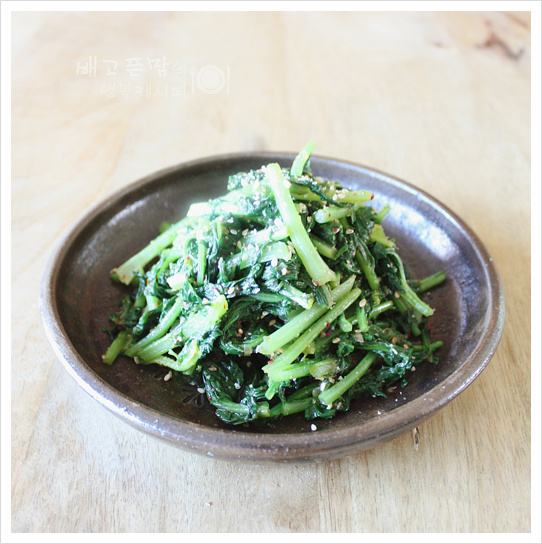Savory Seasoned Radish Greens (Mucheong Namul) – Summer Edition
Radish Greens Recipe, Fresh Greens, Korean Side Dish (Banchan) Tutorial

When you crave a vibrant green side dish but summer spinach isn’t at its best, reaching for tender radish greens (mucheong) from your garden is a fantastic alternative. These greens are perfect for traditional Korean holiday tables or any meal needing a fresh, healthy addition. I often prepare these greens by blanching and freezing them for later use. Thicker stems are great for stews, while the tender leaves become this delightful namul. This recipe uses pre-blanched and frozen greens, but you can absolutely use fresh ones too! Experience the refreshing taste of summer with this simple yet flavorful radish green seasoned dish.
Ingredients- 5 handfuls of radish greens (mucheong) (approx. 200-250g)
- 4 Tbsp soy sauce for soup (guk-ganjang)
- 2 Tbsp anchovy sauce (myeolchi-aekjeot)
- 1.5 Tbsp minced garlic
- 0.5 Tbsp red pepper flakes (gochugaru)
- 2 Tbsp toasted sesame seeds
- 2 Tbsp plum extract (maesil-cheong)
- 2 Tbsp sesame oil
Cooking Instructions
Step 1
For the best texture, select radish greens that are thin and tender. Keep in mind that summer radish greens might be slightly less robust in flavor compared to autumn ones.

Step 2
Fill a large pot with enough water to generously cover the greens. Bring to a rolling boil, then add 1 tablespoon of salt. (Adding salt helps maintain the greens’ vibrant color and shortens the cooking time.)

Step 3
Once the water is boiling vigorously, carefully add the thicker stems of the radish greens first. This ensures they cook evenly with the rest of the leaves.

Step 4
Gently press the greens down with chopsticks or a ladle to ensure they are fully submerged in the boiling water. Blanching in actively boiling water is key to achieving a crisp texture.

Step 5
After about a minute, flip the greens over using your utensil to ensure they are evenly blanched.

Step 6
When the water returns to a rolling boil, prepare to remove the greens. Be careful not to overcook them, as they can become mushy.

Step 7
Immediately after removing the blanched greens from the hot water, plunge them into a bowl of cold water to cool completely. This shock in cold water helps to retain their bright green color and stops the cooking process.

Step 8
Once cooled, gently rinse the greens under running cold water 2-3 times to remove any remaining dirt or impurities. Drain them well in a colander.

Step 9
After draining, gather the greens and gently squeeze out excess water by hand. If you plan to store them, this is the time to pack them into airtight containers or bags and freeze for later use.

Step 10
If using frozen, thawed radish greens, lightly rinse them under running water and squeeze out as much moisture as possible. Then, chop them into bite-sized pieces, about 3-4 cm long. (If using fresh greens, you can skip the thawing and rinsing steps and proceed directly to chopping.)

Step 11
Place the prepared radish greens into a large mixing bowl. (The amount shown in the photo is approximately 5 handfuls.)

Step 12
To one side of the bowl, add all the seasoning ingredients: 4 Tbsp soy sauce for soup, 2 Tbsp anchovy sauce, 1.5 Tbsp minced garlic, 0.5 Tbsp red pepper flakes, 2 Tbsp toasted sesame seeds, 2 Tbsp plum extract, and 2 Tbsp sesame oil.

Step 13
Gently mix the seasonings together on their side of the bowl first. This helps ensure the seasoning will be distributed evenly when you toss it with the greens.

Step 14
Now, using your hands, vigorously toss and mix the greens with the seasonings. Give it a good squeeze and knead to ensure the flavors penetrate the radish greens thoroughly. (Using soy sauce and anchovy sauce allows for easier storage than a doenjang-based seasoning, which should be eaten immediately. As summer greens can be milder, feel free to adjust the seasoning to your preference.)




